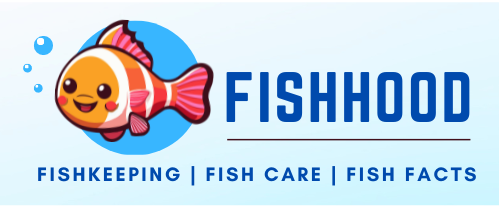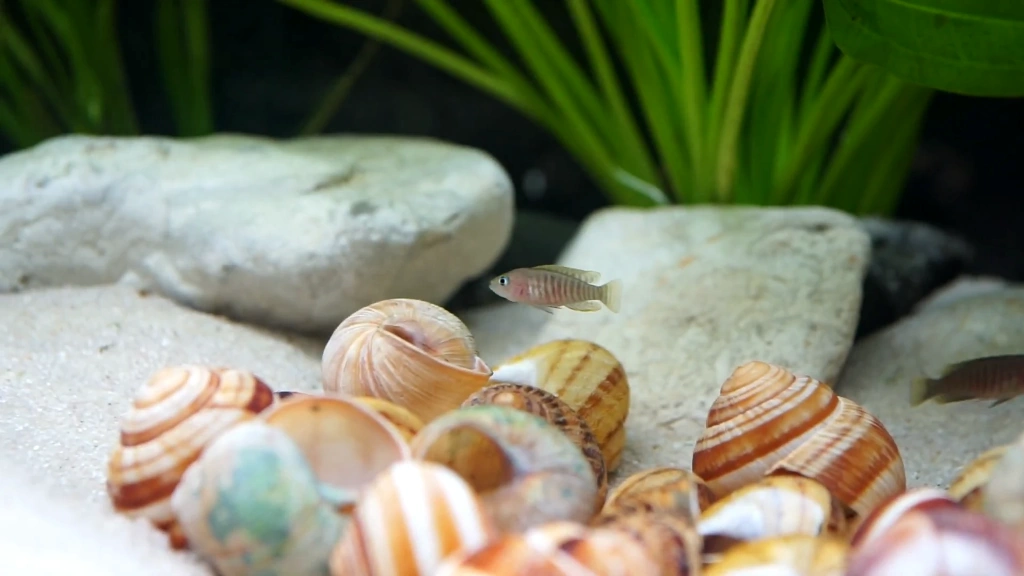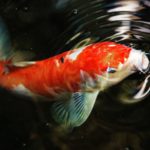Neolamprologus Multifasciatus are believed to be the smallest cichlids in the world. They dwell in shells and are called shell dwellers. They are endemic to Lake Tanganyika in Africa and are tiny, hardly reaching 1 inches in their natural habitat.
Neolamprologus Multifasciatus are popularly called “multies” in the aquarium hobby and they prefer to live in colonies.
Multies are a popular choice for fish-keepers, in the aquarium hobby, that want their fish to be unique. They occupy mostly the bottom part of the aquarium, and live inside shells, provided by the hobbyist.
They look beautiful and have a character in their persona. These cute looking multies, tolerate one another but not other variety of species, especially when they are breeding.
They are listed as Lamprologus Multifasciatus in Ad Konings’ Back to Nature Guide to Tanganyika Cichlids. Both the names are used in the book “Lake Tanganyika Cichlids” to describe this species of fish.
| Name | Neolamprologus Multifasciatus |
| Synonyms | Lamprologus Multifasciatus/ Multies |
| Family | Cichlidae |
| Distribution | Zambian coastline of lake Tanganyika in Africa |
| Diet | Zooplankton |
| Lifespan | 5-8 years |
| Temperature | 76oF – 82oF (24.4oC – 27.7oC) |
| pH level | 8.2 – 9.5 |
| Temperament | Tolerate one another but aggressive towards other species |
| Water Hardness | 8-25 dGH (Hard water) |
| Maximum Size | 1.8 inches (male) – 1.2 inch (female) |
| Breeding | Substrate spawner |
CONTENTS
- Distribution And Habitat
- Behavior And Temperament of Neolamprologus Multifasciatus
- Sexual Dimorphism of Neolamprologus Multifasciatus
- Fries Of Neolamprologus Multifasciatus
- Aquarium Setup for Neolamprologus Multifasciatus
- Setting up and Cycling Your Aquarium
- Proper Care and Aquarium Maintenance for Neolamprologus Multifasciatus
Distribution And Habitat
Lake Tanganyika in Africa houses the most spectacular and unique species of freshwater fishes. When new areas of the lake were explored in the 1970s, a diverse variety of cichlids were discovered. Which soon became very popular among the cichlids enthusiasts.
Neolamprologus Multifasciatus are restricted to the waters of the Zambian coastline of the lake. Found in the sandy areas with empty snail shells, 10-25 meters(35-80 feet) deep.
Behavior And Temperament of Neolamprologus Multifasciatus
If you are thinking, to buy a pet fish, with a character and unique personality, then, Neolamprologus Multifasciatus are the ones for you.
They are always active and doing something. Multies occupy the bottom part of the fish tank. They’ll move the sand substrate with their lower body and spit out the sand with their little mouth.
Always chasing other species of fish when the babies are in the shells. Parents are very protective towards their babies, and are aggressive and territorial. Always defending their babies from other species.
By temperament they are non-aggressive towards their own kind and other species, and have a colony mentality. However, can get aggressive during breeding.
There are some interesting behavior noticed among these fish. Sometimes they form a group and chase a fish away, when they have decided, it will no longer stay in the aquarium.
It is also reported, that they can reject and chase away a male or a female, if the surface area is too tight for the colony. The rejected Neolamprologus Multifasciatus, then, has to occupy the upper part of the tank for its survival.
Sexual Dimorphism of Neolamprologus Multifasciatus
Male and female multies are sexually monomorphic (according to wikipedia). This means that the gender of the male and female Neolamprologus Multifasciatus is very hard to determine based on their physical appearance alone. But, there is considerable size difference when they reach adulthood.
Males tend to be longer than the females and have a reddish or yellowish tint, at the top. Also, males have a blue color tint in their eyes.
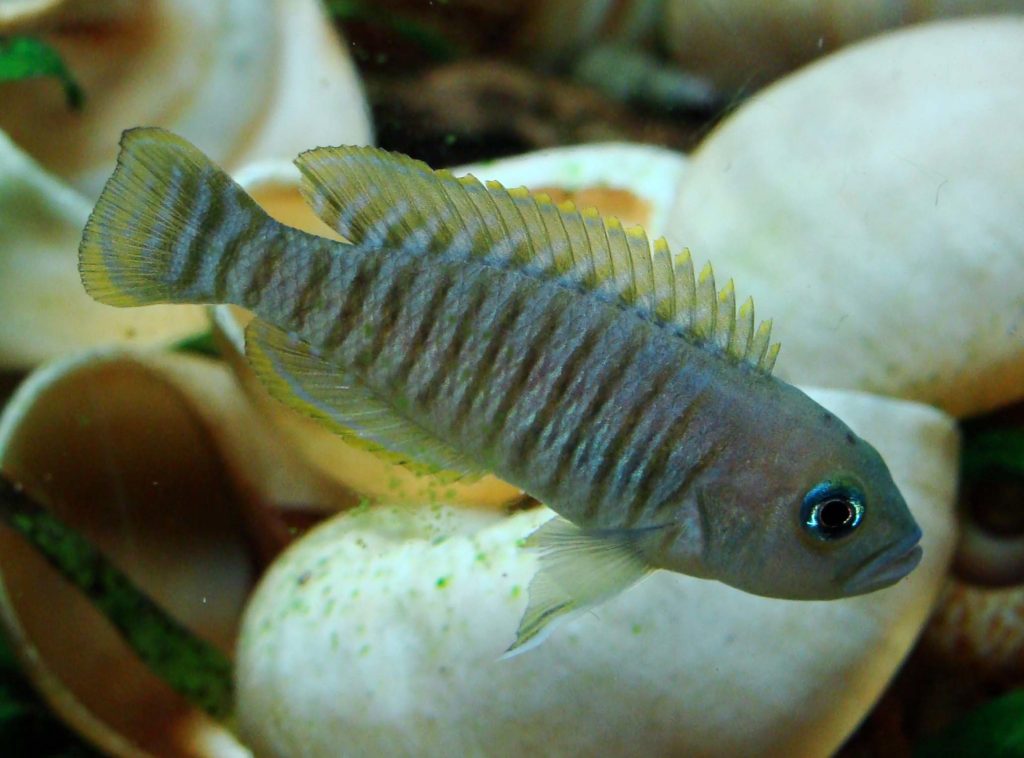
Males are reported to be around 1.5 to 1.8 inches in length. In the wild they reach up to 1.2 inches in length according to wikipedia, some may find it to be weird. But, in the wild they have natural predators and in the aquarium setting they don’t. In the fish tank they get a lot of time to grow, and breed easily, and hence getting a bit longer.
Males’ territory consists of a pit in the sand with a bed of shells in the center. 5 to 8 shells can be seen in their territory. They make these sand mound like structures all over the fish tank. They’ll push or pull the sand substrates until they get their perfect sweet home kinda setting.
Male may spawn with various females within its territory. Males are longer than the females and are aggressive to other variety of species while breeding.
Female Neolamprologus Multifasciatus
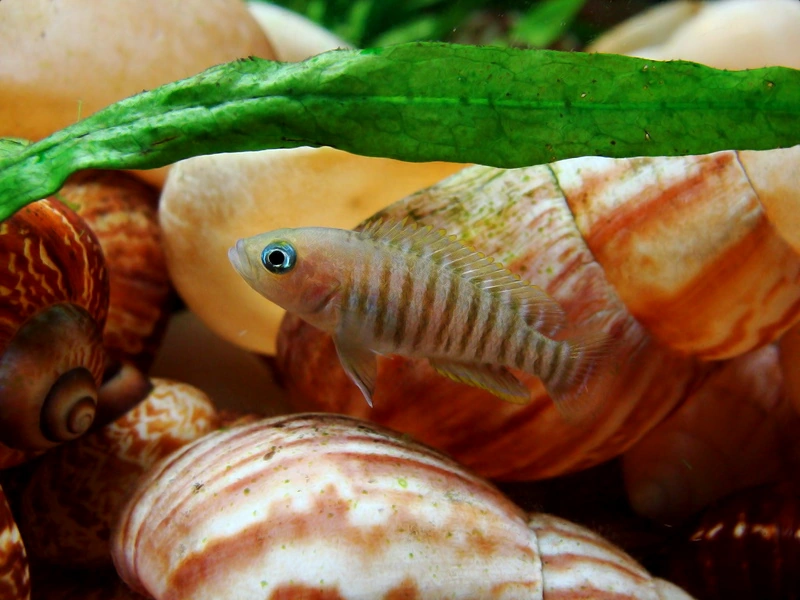
Females are smaller, in size, mostly 1 inch in average, excluding their tail fin. Females don’t usually have yellow lining on their fins. They entice the males, into their individual shells for breeding. You’ll be surprised to hear that right?
Female Neolamprologus Multifasciatus is seen to do tricks to entice the male. Like spitting the sand, out of its mouth, and may come near the male and then quickly swim towards its shell. Breeding takes place in the shell of the female.
Both parents will guard, the babies and their territory actively. Multies are effortless breeders, you just provide the right water parameters and they’ll breed.
Fries Of Neolamprologus Multifasciatus

Spawning takes place in the shell of the female. You can see 1 to 10 fries coming in small and manageable clutches. Neolamprologus Multifasciatus don’t eat the fries. They protect their babies with a passion. Males become aggressive after the spawning.
They will attack any fish coming, in close proximity of their shells or babies. Females also take an active responsibility in protecting their young ones.
Behavior Of The Fries
You can barely spot these fries at first, as they, spend a lot of time inside the shells. After a few days, they get a little active, and spend a lot of their time around the bases of the shells. They hide a lot at first, and come out only when they sense food.
These fries after emerging out of their shells, are large enough to eat brine shrimps, crushed flaked foods and microworms. They start to explore, the aquarium, when they start to grow a bit longer.
Fries of the Neolamprologus Multifasciatus are not seen swarming near their parents.
Feeding The Fries
If you are considering what to feed your multies take a look at the list below.
- Flakes – Crushed or finely grounded fish flakes is given to the fries. Their mouths can be, too small, for normal sized fish flakes.
- Pellets – 0.5mm micro pellets are recommended for the baby multies.
- Daphnia – This can also be fed.
- Micro-worms – Baby multies enjoy micro-worms a lot.
Aquarium Setup for Neolamprologus Multifasciatus
The habitat preference of Neolamprologus Multifasciatus is bottom oriented. Since, they are, a bit on the aggressive side, a rule of 2 gallon of water per 1 inch of fish (body length) is good, to maintain a peaceful environment.
You should not tightly stock them in a small aquarium. They might attack and drive away each other. They are seen, to drive away a female or a male, from the colony, if the space is too tight for them.
Now, the drove out member of the tank, have to find a place for itself, in the middle, or the top part of the fish tank, without a shell, which is a bad place to be in for the Multifasciatus.
Tank Size
You should get or plan an aquarium, with a large bottom space, and not much of a height, which helps bottom dwellers feel secured. Large bottom space in an aquarium will enable you to decorate the space, with rocks and shells, which will make them feel more secure.
If you can make multies feel secured, with a good bottom space, rocks and shells to hide, they will be calmer, and won’t attack each other.
Neolamprologus Multifasciatus are the smallest shell dwelling cichlids. A 10 or 15 gallon capacity fish tank, will be a good starter aquarium. Anything, below 10 gallon might get a little too tight, for these species.
Atleast, 2 pairs, are recommended, for any tank. Select the 2 of largest and the 2 of smallest adult fish in your local fish store that are wild caught. The chances are that you’ll end up with 2 males and 2 females. This will ensure their breeding process.
Providing Shelter and Hiding Place for Neolamprologus Multifasciatus

Escargot shells (extra large) are a perfect fit for these smallest shell dwellers. These shells are snail shells, and you need the larger ones; the larger the better. Spawning can take place easily in these shells, and it also acts as a shelter for the fries of Neolamprologus Multifasciatus.
Each fish, should be kept in its own shell. Provide a shell for each of the individual fish. The number of shells should be equal to or more than the number of multies in the aquarium.
Fish-keepers add oyster shells and snail shells, into the aquarium to increase the hardness of the water. Addition of escargot shells will boost the water hardness and will help to maintain the water hardness level.
Be sure to wash and clean the shells properly, before the initial use.
Rocks
You can use rocks in your aquarium for many purposes. It can provide a sense of refuge and security for the multies, as well as for decorative purposes. You can use large rocks like the Texas Holey Rocks to make your aquarium look bigger.
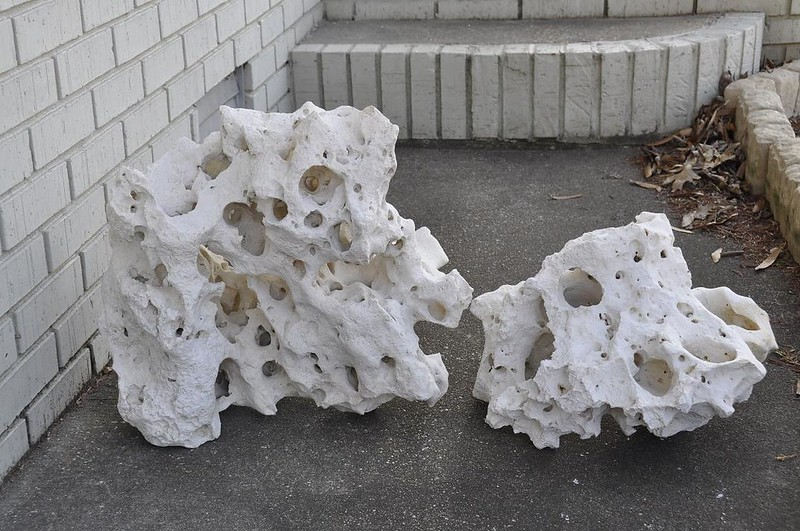
Texas Hole Rock is a limestone made by the combination of calcite and dolomite. This type of rock is great for African Cichlids which flourishes at a pH between 7.5 – 9. This type of rock provide small crevices and holes, which are perfect for Neolamprologus Multifasciatus to hide and play around.
Make sure the rocks are smooth and are not sharp edged. Sharp rocks should be avoided at any cost, this will injure your pet cichlids as they accidentally scrape against the sharp edges.
What Is The Perfect Substrate For Neolamprologus Multifasciatus? Gravel or Sand?
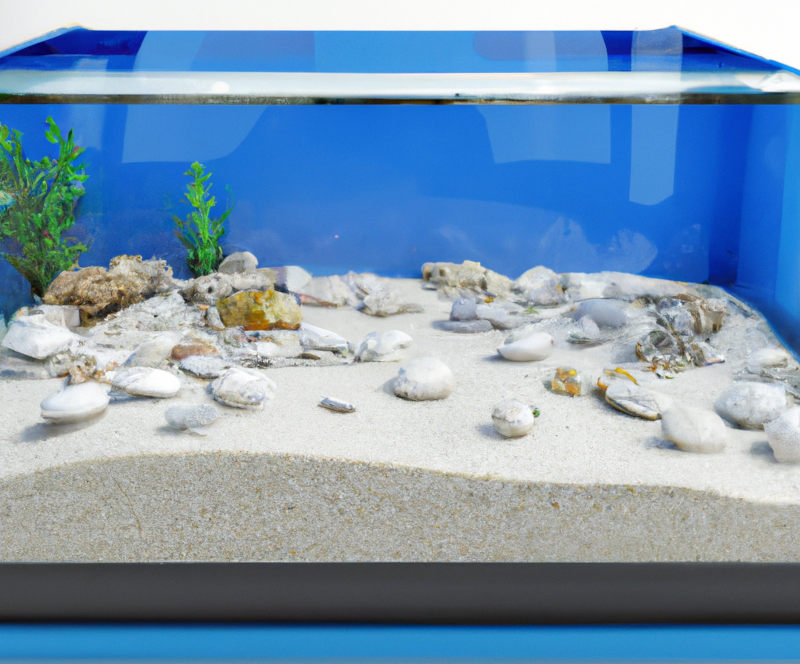
Most fish-keepers use white sand substrate for the multies. It looks good and eye pleasing, also multies play a lot with the sand. They rearrange the substrate and make it their own. Neolamprologus Multifasciatus exhibit their natural behavior when they are kept inside an aquarium with white sand substrate and some larger shells.
Multies like deep sand bed in aquariums, at least 2 inches thick, but be sure you don’t put too much sand in your aquarium, this will invite different kinds of bacteria to form anaerobic conditions in the deeper parts of the sand bed, in the long run. Avoid very thick layer of sand in your aquarium.
You can use Carib Sea African Cichlids Sand (aragonite sand) or coarse sand from your local pet shop. Aragonite sand helps to increase the pH of the water, which is good for Neolamprologus Multifasciatus.
If you are planning to use gravel, then, use fine gravel to cover the bottom of your aquarium. But, multifasciatus prefer sand, because in their natural habitat they dig up the sand and place their shells on it.
Whether you are using sand or fine gravel, it must be properly cleaned before it can be used in your aquarium.
Lighting
Lighting plays an important factor when you have live aquatic plants, in your aquarium, and most cichlids show better coloration when the light is subdued. So, as long as we can see what is going on in the aquarium, you don’t need additional light.
Lighting should not be too intense as Tanganyika cichlids will lose their color in strongly lit aquarium. Natural sunlight is the best source of light but you need to ensure it does not directly heat the tank a lot.
If you are using a smaller tank of 10 or 15 gallon, a basic led aquarium light will be enough. For larger tanks figure out proper lighting by adding 1 aquarium light after another. Just make sure you don’t use too much light, just enough, to see what is going inside the aquarium easily.
Setting up and Cycling Your Aquarium
The idea of setting up and cyclying your tank is to provide a better, more habitable environment for your Neolamprologus Multifasciatus. You have to prepare your tank, weeks before you can add multies in the tank. Your tank needs to go through biological filtration process in order to be prepared for your multies to live inside the aquarium.
Biological filtration is crucial for keeping the fish in an enclosed environment. Without it the fish will eventually die. You need beneficial bacteria in your tank to cycle the aquarium and maintain water parameters.

Several organic materials such as uneaten food, fish waste, decaying plant matter, rotting fish are mineralized by heterotrophic bacteria, with the result that ammonia is produced. Ammonia is very toxic to all kinds of fishes.
Additional bacteria further oxidize the ammonia into nitrites, and still other bacteria convert the nitrites to nitrates. This is called nitrification process or biological filtration in a nutshell.
When you first install your filter, it takes roughly about 4 to 6 weeks to grow enough beneficial bacteria that can efficiently process your fish’ excrement, uneaten foods, and decaying plant matter.
So, it takes some time to kick-start the whole filtration process. The 4 to 6 weeks waiting period is the maturation time, and we need a “test fish” to complete the tank maturation process for us. You cannot put your Multifasciatus in there, until the maturation process is over, or they will have a very low chance of survival.
Test Fish
For a “test fish” you should prefer a fish that is extremely hardy and can withstand high level of ammonia and nitrites. Most tropical fish fall into that category.
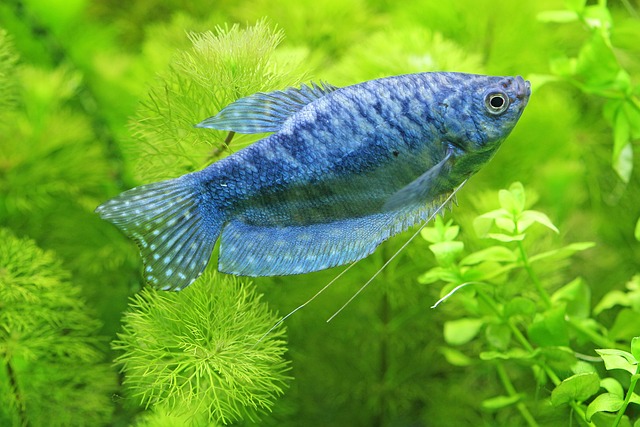
You can get some inexpensive hardy “test fish” like Paradise Gourami or the Blue Gourami, if you are planning to build a large aquarium.
Some hobbyists use Pearl Danio and others use Platies as a test fish for a small Multifasciatus tank. These fishes can survive the spike of ammonia and nitrite during the cycling process.
You can add nitrifying bacteria into the tank water to introduce the beneficial bacteria early on to speed up the process. And these bacteria will breakdown the test fish’ poop and begin the nitrification process.
This process will come to fruition after 4 to 6 weeks, and after that these test fish can be moved to a separate tank, because Neolamprologus Multifasciatus should only be kept with Tanganyika cichlids, considering the water parameters and territorial dispute.
Proper filter is another factor during the setup and maturation process of the tank.
Filter Selection
Some people use preinstalled sponge filter from an existing fish tank into their new tank setup for multies. So, that the beneficial bacteria, that are present inside the sponge filter can colonize the aquarium water quickly.
Most hobbyists use basic sponge filters for their multies tank, and these filters are quite capable of removing the fish waste, uneaten food, and decaying plant matters effectively.
Sponge filters are great for Neolamprologus Multifasciatus and their babies; their surface is too small to entrap any fries and juvenile multies. Fries won’t get caught inside these filters. It is safe for the fries and good for a breeder tank.
Keep in mind that, after a prolonged period of use, the the sponge will breakdown and needs to be replaced. So, you have to reestablish the process of biologically maturing the filter. You can avoid this, by starting up another filter, 2 months prior replacing the old one.
Most cichlid-keepers don’t recommend to use an under gravel filter to be used inside the aquarium for your multies, because they dig the sand and expose the under gravel filter. This makes it less efficient and the filtration process is hampered.
Aquarium Water Chemistry
The waters of Lake Tanganyika have a very high pH and alkanity, also mineral deposited by shells and rocks make the lake waters very hard. So, Neolamprologus Multifasciatus prefer high alkaline and hard water. It will be wise to match your aquarium water to that of Lake Tanyanika.
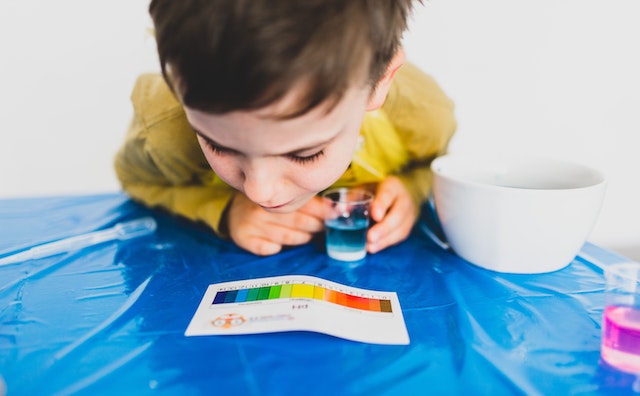
The pH in the lake can range from 8.5 to 9.5 with a total mineral hardness of 12 to 14 kH, of German hardness (200 – 240 ppm of carbonate hardness). Most tap water in USA have a pH of 6.8 to 7.6 and the total mineral hardness may vary substantially.
It is recommended that you measure the pH and water hardness of your tap water using test strips. You can also have your water tested at the local retail tropical fish establishment.
By measuring the water hardness and pH level you’ll be able to determine whether your water needs buffering to increase the pH and kH. If you live in an area where your tap water has a relatively high pH and kH, nothing more needs to be done to increase the pH and kH.
If your tap water contain chlorine, chloramine, heavy metals, and other contaminants, then you need to add water conditioner to remove these contaminants that can harm your fish.
Heater and Thermometer
Neolamprologus Multifasciatus are susceptible to temperature changes. Water temperature must be between 76oF – 82oF (24.4oC – 27.7oC), at all times, which is the normal water range in Lake Tanganyika. Heater is necessary for very cold climate.
Multifasciatus don’t like too much variations in temperature. You also need a thermometer to measure the temperature besides the heater. An accurate thermometer is vital to establish the correct water temperature.
To determine determine the size and wattage of heater your aquarium needs, you can refer to the back of the heater to read the instruction and specifications of the packaging. Another way is to follow a general rule of about 3 watts per gallon, suggested in the book “Lake Tanganyika Cichlids”.
Suppose you have a 50-gallon aquarium, you’ll need a 150-watt heater, according to the above book. Mount the heater in the aquarium only after it is full of water. Before installing the heater, install an accurate thermometer in the aquarium.
Maintain the water temperature at all points, it is very necessary for the multies. When you give them correct water chemistry and correct temperature their breeding is effortless.
Proper Care and Aquarium Maintenance for Neolamprologus Multifasciatus
Once your Multifasciatus aquarium has been set up, it must be regularly maintained. Doing so will assure the shell dweller’s long term health.
In this section you’ll learn about the proper care and maintenance of your finny friend. You’ll learn about water changes, test kits, proper diet and food for your pet fish.
Water Changes
Regular and frequent water changes should be a standard function for keeping your shell dwellers. To ensure proper care for your Neolamprologus Multifasciatus, regular water change is a must.
Several factors determine when, how much amount, and how often you should change your aquarium water. The number of Multifasciatus you are maintaining, the amount of food offered at each feeding, and how many times a day you feed your multies are all important factors that will determine your water changing routine.
Your filter’s overall performance, and the amount of plant life you have inside your aquarium, are important factors as well. If your stocking density is low and there is plenty of room, in there, for your fish to live, then a 25% of volume of the aquarium’s water should be changed weekly.
33% of the volume of the aquarium’s water should be changed every 2 weeks, if it is sparsely populated (1 inch of fish per 2 gallon of water).
If you crowd your Neolamprologus Multifasciatus (1 to 2 inches of fish per gallon), then do 40% to 50% water changes weekly. These are rough guidelines, and you need to monitor the nitrate levels after setting and cycling your tank for the first time.
Water Hardness
Add some cichlid salt after every water change if your aquarium water is on the softer side, just to increase water hardness . Water hardness is vital to your Multifasciatus.
Rocks and shells release minerals into the water contributing to the water hardness. If you have soft tap water, then, you can add crushed corals and rocks to release the minerals into the water.
Maintain the water hardness between 8 – 25 dGH. If you see your multies struggling and shaking, then, add a little cichlid salt and wait for some time. This should stabilize them.
Test Kits
Multifasciatus don’t do well with nitrates and ammonia. Most Tanganyika cichlids including multies can survive high nitrates level only for a while, but maintaining them with nitrates level above 20 ppm is a lot of trouble.
Multifasciatus kept in water with high nitrates level for longer periods of time will become weakened. They will face trouble resisting parasitic or bacterial infections, if prolonged exposure to nitrate continues.
You should invest in high quality test kits to ensure the safety of your multies. After your aquarium is cycled you will test for nitrate level to determine when you need a water change.
Diet
Diet for multies mainly consists of zooplankton. You can offer a variety of aquarium food that closely resemble their natural diet in the wild.
Feed your multies two times a day. Nowadays Tanganyika cichlids food are easily available online and also at your nearest pet store. It can be in the form of flakes, pellets or live food.
Daphnia and baby brine shrimp are favorites of both the parents and the fries. If you are planning to feed flakes then make sure it fits their mouth by crushing or appropriately grinding it.
Put some crushed flakes into your aquarium and see if they are comfortable eating it. If not, then you need to grind the flakes further.
Choose small size pellets, 0.5 mm are used by some hobbyists. Supplement the diet with baby brine shrimp.
Aeration
Oxygen is very important for your Neolamprologus Multifasciatus and the beneficial bacteria in the aquarium water. Without proper oxygen they would die out. The aquarium water should be saturated with oxygen at all times.
Air pumps or air stones help oxygen get into your tank. It is very hard for oxygen to enter stagnant water. Air pumps or stones agitates the surface of the aquarium water and helps oxygen to blend in with the water and thus increasing the oxygen level in the tank.
Pump forces the oxygen into the tank water, which is distributed throughout the aquarium, via an air stone or a filter. The air pumps or stones, pump bubble right into the water and the bubbles go up towards the surface of the water. Then, the bubbles pop and creates surface agitation and helps oxygen to mix into the water.
You can install an air stone inside the sponge filter of your Multifasciatus tank via an airline tubing air pump, if you have a smaller tank or so. Some say it increases the sponge filter’s efficiency.
Just make sure that you are seeing those bubbles coming out of your installed air pump wherever it it installed in your aquarium. This should provide adequate oxygen into the water coupled with regular water changes.
When you change water of your aquarium, you are replacing the old oxygen depleted water with oxygen rich water. This improves the oxygen level of your multies tank also.
References
- Back to Nature Guide to Tanganyika Cichlids – Ad Konings
- Lake Tanganyika Cichlids – Complete Pet Owners Manual – Mark Smith
- Texas Holey Rock
- Species Profile and Behavior | Prime Time Aquatics
- Sexual Dimorphism of Neolamprologus Multifasciatus | Wikipedia
- Neolamprologus Multifasciatus water parameters, life span and others | Aquariumwiki
